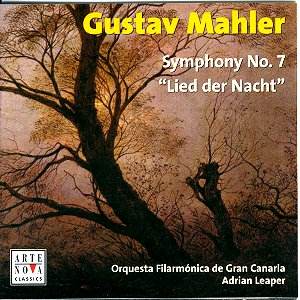Many recordings of Mahler's 7th Symphony span two CDs
and cost in excess of £20. This one is on a single disc costing less
than £5. With acceptable orchestral playing and recording quality it
is therefore worthy of serious consideration, either as an indulgent
extra recording for the curious enthusiast, or for anyone wanting to
acquire this great symphony at minimal cost.
Adrian Leaper is an experienced conductor, as he was
back in 1995 when this recording was made. Too little used by orchestras
in Britain, he has carved a successful career in Europe with many acclaimed
recordings to his credit. He clearly knows and loves the music of Mahler,
since he generally chooses appropriate tempi and phrases the music with
loving care for details of expression. For there is no question but
that this is a well paced and idiomatic performance of a work which
does not always receive its just desserts in the Mahler canon. Some
of the music is as distinctive as Mahler ever conceived. For example,
as the first movement develops there is a gloriously noble pastoral
evocation, which Leaper allows due prominence and indulgence, even if
the lustre of the Gran Canaria strings cannot match that of some of
their more famous competitors (the Concertgebouw Orchestra under Bernard
Haitink on Philips are splendid in this music).
The second movement scherzo is strongly shaped by Leaper,
and the solo horn who sets the tone does so with considerable aplomb.
Perhaps the central scherzo movement might have gained from more rhythmic
bite; and the slow movement which follows as the fourth in the sequence
might have gathered more romantic ardour. But no matter, since this
performance remains committed and worthwhile.
The Rondo finale is always a tricky challenge to performers
of this symphony, and tempo relationships are notoriously difficult
to balance. Leaper paces the music well, though from the beginning the
individual sections of the orchestra are somewhat under characterised
in comparison with the best of the competition (try, for example Rafael
Kubelik with the Bavarian Radio Symphony Orchestra on DG). The production
is perfectly acceptable as far as the general presentation and the richness
of sound quality are concerned, though the latter is certainly not in
the demonstration class. The booklet contents are thin and a little
disappointing, though it has to be stressed once again that the performance
is not. In short, this is well worth the modest outlay involved.
Terry Barfoot


